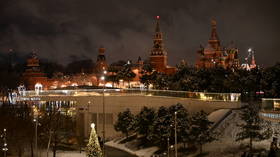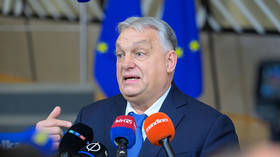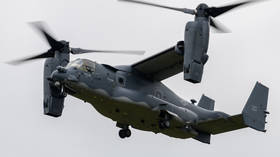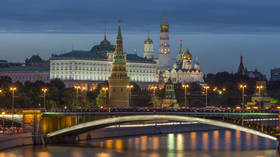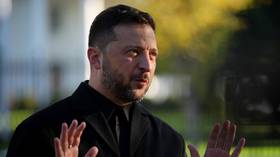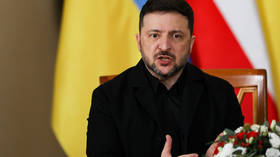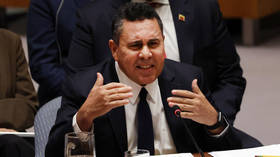"I could see Armstrong bouncing on the moon"
Russia's prominent cosmonaut, first man to walk in space, Aleksey Leonov strongly rejects claims that Americans made up their moon mission and shares with RT his memories of Neil Armstrong walking on the lunar surface.
RT: Your 23 minutes in outer space turned a new page in human history. What did it feel like?Aleksey Leonov: I can remember the first words of Sergey Korolev. They were instructional and educational. It was the year 1962, and he had invited us to his R&D bureau. We saw the assembly line and the ships under construction. One ship was different from the others, which were all “Vostoks.”Korolev said: “Meet Voskhod 2.” What made it different? A different engine system which added a retrorocket, and an extra 1.3-by-2.3 meter cylinder.Next, Korolev told us that a sailor aboard an ocean linear has to be able to swim. A cosmonaut aboard a spaceship has to be able to “swim” in space, as well as perform installation and de-installation tasks. Otherwise, we won’t be able to do anything.So, he looked over our team of 20, and he stared at me and said: “Hey, ace, you put on the space suit.” He told me to try doing the full routine – spaceship, airlock, outside, airlock, spaceship. “Also, submit your report to the technical command in two hours.” Of course, this was one of the most important tasks in my life. Later, I often thought whether it had been a mere coincidence or not. Why did he choose me out of these 20 guys? Gagarin was there, too. In fact, it wasn’t by accident. Korolev said a lot of good things about me at the command meeting. He had studied my CV carefully. But I only learned about it 30 years later, when I read the minutes of that meeting. This is how I made it into this program.Today, we don’t even pay attention when we’re told that cosmonauts go into the outer space and do extra difficult work. This is how the Hubble telescope was saved, and how they saved the second space station, when one of its docking elements got damaged. Anatoly Solovyev holds the record – he went out 16 times.I don't even remember my first reaction, but it has been recorded. I said: “Wow! The Earth is round.” You believe it when you are told, but when you see it for yourself, it is a unique experience.I am often asked about my feelings. But this is the classic idea of feelings – how you experience your surroundings. Blue Earth, bright Sun, like today, black sky, non-blinking stars. They are seen at the magnitude of 6 in space, and only at 3 on Earth. So the sky is filled with the glowing dots. And you feel the depth. The temperature, theoretically speaking, was around 3,000 degrees. But you don’t feel temperature in quite the same way in a vacuum, because molecules are few and far between. It’s better to think of body temperature when placed in this environment. The temperature was plus 150 degrees on one side of my space suit and minus 140 on the other. But on the inside, it always was a comfortable plus 20. Besides, when I came out, I had to do some hard physical labor, so I raised the temperature by 1.8 degrees in a very short time. If you warm up a healthy person by 2 degrees, it’s lethal.I only had 60 liters of air for ventilation. Today, astronauts have 360 liters! Plus, they have a heat-distributing shirt with cooling liquid flowing inside it. That’s why today you can stay in outer space for 6-7 hours. But the decision to develop this technology was made after the first command meeting, where I reported on my experience in space. One of the Soviet R&D plants was ordered to develop a new space suit which would be “one size fits all” and would have extra heat distribution. It’s so powerful that today, the guys are complaining that their feet are always getting cold! But that decision was instant and strong-willed. In five years, we got a new space suit with a metal torso and adjustable features.RT: You faced quite a few difficulties during the mission. You landed in taiga in the Perm region and spent more than two days in the cold. I understand that cosmonauts are strong people, but still, how did you survive?AL: A couple of days ago I saw Yevgeny Ryabchikov’s film. It was shot shortly before the next flight. They didn't know how to explain what was happening to us. Nothing was said about problems with entering. Apparently, everything was fine. But they commented on the critical situation, saying it was because of the “failure in sun orientation” – as if “the sun broke down.” So stupid! In reality, the automatic landing control system failed; it uses the sun as an element. It is like a solar watch which tells us where we are in relation to the sun. But the sun can’t break down! What did break down was the automated orienting system.So we were forced into orbit again. One circle around the orbit is 1,500 kilometers from the next one on the equator. This meant we couldn’t land where we were supposed to. Our new course went straight through Moscow, and we could land there, or in Nizhniy Novgorod, or in Perm. But we chose the landing site ourselves, without any enterprises, pipes or power lines, which we were especially afraid of – our parachutes had 50-meter-long cords. You could burn alive if you touched a power line. So we chose this remote, desolated area in taiga as a landing site, 170 km from the town of Solikamsk. For us, taiga was like a flat lawn.It wasn’t that difficult to find us. Before the flight, I took an administrative map and marked our circles on it. Also, I marked the spots where engines could be turned on and the respective landing spots. I didn’t have to make any calculations. I just took a photo of it and put it into the flight log journal. It was as if I knew this would happen to us.When it did happen, we knew we had very little room for orientation, and we couldn’t allow for making mistakes. If we went wrong, we were done for: there was not enough fuel for a second try. Plus, we turned off the automatic orienting system five minutes before we turned on the engines to save some fuel. There’s one more detail you need to know: “Voskhod 2” had a control system located at 90 degrees to the pilots’ seats. We sat along the ship’s main axis with the pilot wheel in our hands, but we had to turn our heads to the side to see the screens. We had to make adjustment for these 90 degrees for every maneuver decision we made. It was impossible to control the orientation. I had to leave my seat and go to the airlock while Pavel Belyayev was at the wheel. Also, we were afraid we’d start spinning.We landed 80 kilometers off the point I had marked on the map. We had a special system for measuring our location. I opened the hatch and used a sextant to make the first measurement. In theory, I had to make another one in 20 minutes to get two point coordinates. But we didn’t make it – a snow storm started outside, so we climbed back in and shut the hatch. When it stopped, we looked outside again. It was very cold, minus 25 degrees. The trees were cracking in the frost. We started freezing. I had water up to my knees in the space suit. So we took the suits off in this cold, ripped up the isolation material – nine layers of aluminized foil – and put the hard bits on the snow. This way, we could move around. When Pavel climbed out, he dipped into the snow up to his chin. The snow was 1.5 meters deep. It was in March, and the snow was soft and loose, like salt.We spread the space suits on the snow, so that we could stand on them. I set up the radio station and started sending a signal. I used Morse code, but no one could hear us. We were in the middle of the taiga. Neither Moscow nor Perm picked us up, but they heard us in Petropavlovsk-Kamchatski. They even heard us in Bochum Observatory, near Berlin.It was getting dark when we saw an AN-12 plane circling in the sky above. I later found out that the crew commander was Vladimir Kovalyov – he went on to become a member of the Soviet cosmonaut crew. Then there were more planes and helicopters. There was a plane going round and round at night – they said they used the noise from the propellers to keep away the bears and wolves. There were no bears, really, but we could see wolf footprints in the morning. This is how we spent the first night. Next day, a helicopter landed six kilometers away from us, and the landing party reached us on skis. Among them was Vadim Volkov, who later flew in my ship and died in my ship.RT: The first stage of Mars-500 project was completed last week. How realistic is this idea of a flight to Mars?AL: So far the Mars program is more of a phantom. I don’t know of any country that could say for sure that they are starting the Mars program and allocating a certain amount of money to it. This has not happened yet. Therefore you can say whatever. Sergey Korolev worked on the N-1 rocket, keeping the Mars program in mind. And that was back in 1962. We could say that we began working on the Mars program back then. But it would not be true, because it takes a definite decision to do it. One thing is clear: no individual country, like Russia, the US, Ukraine, will do it. This will be an international program.And the crew has to include six people minimum. And there have to be representatives of many countries – the US, Russia, the European Union, Japan for sure, maybe Mexico, Brazil, other countries.If we make this decision today, then count off 15 years, and in 15 years we will be able to launch the mission. We should not only create the technology, but we also need to train crews. These crews have to be different than what we have today. They have to get special psychological training. They should complement each other. Today they might be 10-11 year old boys or girls. We need to teach them to understand each other, be tolerant. They should learn languages and be able to function in different climates. Anything could happen. We ourselves ended up in taiga back in 1965. They could end up anywhere, in the Sahara, for example. These crews need to make a few flights together, work on the orbital complex.What do we have today? The energy carrier, we could restart its production. Secondly, we have experience with long-term life support systems. Titov was in space for a year, Yury Romanenko flew for 11 months. Sergey Krikalev, 844 days, enough to go to Mars and back. Russian life support systems are unique, no other country has anything alike, and they allow you to work in space for three to five years. Take water for example. You need three liters per person daily. So you figure out how much water you will need for two years. You can't do anything without the regeneration system. Russia has a very reliable system.RT: You were one of the cosmonauts who were getting ready for the USSR manned moon mission. But the program was closed and Americans became the first humans to walk on the moon. How did it happen?AL: This is a big disappointment in my life, because three years were lost. The training was extremely difficult. We had three crews who were supposed to orbit the moon, and then two people were going to land on it. The first part was going very well. During the very first flight there was an annoying error with the engine – the positive charge was mixed up with the negative charge. So the engines began to work in the opposite direction. The ship stopped at the intermediate orbit. It is hard to imagine now something like that happening, you can't even mix charges on car engines. The rocket industry was not connected with the jet industry. And things that had been worked out in the aviation were not applied in rocket construction. We had two accidents; people were killed, because aviation technologies had not been applied.There were six launches under the moon orbiting program. In 1962, Kennedy announced landing on the moon was part of the national program. They didn't expect Gagarin’s flight to space and the first man in open space. Brown himself told me: “We have not even thought of that. Technology allowed us to do it, but we did not have Korolev, so we lost the momentum.” Time was crucial here. Rocket industry takes time, and you can't speed up the process. The technology is strictly time tied. And they lost the momentum, later trying to make up for it. When White went into open space, he depressurized the whole space craft, which is very dangerous.RT: The US is often accused of not actually going to the moon and faking the images from there. What’s your take on that?AL: That is ignorance, total ignorance on the part of those who say so. These people don't know anything about technology. Or they just seek popularity. Only two countries did not monitor the orbiting of the moon and landing on it. It was during the Cold War. There were systems, monitoring planes as well as rockets. Our radars monitored everything. We did not have a mission control center. There was a space communication military base in Moscow. Americans announced the start of Saturn-5 with Frank Borman as the commander. We observed the start of the rocket, Americans were transmitting it to the whole world, and only two countries were not watching – the Soviet Union and China. Out of stupidity. We saw all four adjustments. Our systems saw how a huge meteor came from the south and landed.One interesting fact: Frank Borman came here some time after the flight. Crowds surrounded his hotel every day. The government held a great reception for him, there was a press conference. Our people greeted Frank Borman just like they had greeted Gagarin. It was pure joy!We could have orbited the Moon before Frank Borman. All the tests were going great. We were asking to go on L-6. “No, let's do more tests.” Korolev had died, and Vasily Mishin took over. He was an excellent engineer, but he didn't have Korolev's strong leadership skills.Our engineers didn't like the risk. So they launched the sixth unmanned craft, which landed 600 meters away from the launch. Precision, all systems worked perfect, but it was unmanned. This was the most painful thing. We had all the chances to orbit the moon before Frank Borman did it. As far as landing goes… We were supposed to orbit the moon three times and then pick two crew members. Americans planned for two people to land, we planned one.I was the lunar team commander and in charge of the group training. We had three crews on the team altogether. So, when the Americans announced their mission, we all gathered at this military base. We sat there, holding our fingers crossed. We wished all the luck to the guys. We personally knew them, and they knew us. Radars were monitoring the whole process. When the ship landed, their external cameras began to show the surroundings. We saw it all. Then the hatch opened, the next camera turned on (they really had thought it all through). Armstrong goes down the steps. The last step was about 50 cm above the Moon's surface. He was moving his foot carefully. We all froze, waiting to see what was going to happen next. He jumped off the step, then bounced and began to walk. He had an antenna that transmitted everything to the Earth; we saw everything that they did. The question about the wind on the moon: There is a copy of that American flag in the museum. The flag was taken out of the case and unfolded. And this unfolding looked as though the flag was being moved by the wind.The rumor started when Stanley Kubrik's wife commented on her husband's work. She said that it was very difficult to make the film about Americans landing on the moon. Well, it is understandable. There are two ships left on Earth. One is at the Smithsonian museum. It is not allowed to even take pictures there, because the displays there are extremely valuable. And the second ship, the exact copy, is in Hollywood. So he did some of the shots there, things like landing, opening of the hatch. Because otherwise viewers would not get the whole picture. So that's how the rumor about the landing on the moon footage being fake started. Two people even went to prison for bearing false witness.When it got to our journalists, they began to spread all kinds of nonsense. There were two idiots showing pictures of the Earth taken from the moon. They said they were optics specialists, and apparently it was impossible to take such a detailed picture of the globe with all the continents and even rivers. The funny thing is we ourselves took this picture from our unmanned craft, using the camera made by one of Moscow's optical labs. We did this! How dare they say things like that! And we had two unmanned vehicles for nine months there. It is such ignorance to say that Americans were never there, but we controlled our vehicles from the Earth. It is simply impolite. But it is even more impolite that only two countries did not watch the mission – China and the Soviet Union, both Communist countries. It is just idiotic nonsense; they robbed their own people off this experience. It is like if we didn't show it, that means it never happened. Like a cat that sneaks in somewhere with closed eyes, thinking it is invisible. It was wrong for such a great country to do something like this.RT: Does it make sense to continue the research of the moon today?AL: It does not today. But it is impossible to stop the process. It makes sense to go back to the moon, even in terms of the economy. This would be a great foundation that will bring us closer to understanding the universe. It would be much easier to work there, compared to the space station. We can do all that. Of course, we can always complain about lack of finances. But we shouldn't do this alone anyway. China wants to do its own moon program, but they don't have what it takes.China used the Soviet technology. I presented the construction of the Soyuz space craft to two major commissions. They basically copied our ship and the rocket. They would not be able to do anything without us. They have built up some potential now, but as far as I know they don't have reliable life support systems.RT: You are known not only as a cosmonaut, but also as an artist. And some call you the founder of a new sci-fi style. Did your inspiration come from space? AL: Yes, I am a member of the Artists’ Union. I was elected head of the space art group. I was the first one to integrate science in the process. For example, I used scientific methods of calculating the size, color grade. I built a special device for it. Two years ago I received a special award from the Russian Academy of Arts.I have been into all that since I was a child. I regret not getting a formal education. I tried to study at the Arts Academy in Riga, but other things got in the way. A couple of months ago I had my biggest exhibit with 80 pieces. People lined up outside the exhibit hall, waiting to get in.The exhibit was called “Earth and Space Art.” I also had a few portraits there. I tried to draw different parts of the world that I have traveled to in recent years. My space works are in different museums. Gagarin's museum displays about ten of my paintings. One of my space works is in the Dresden Gallery, in Tashkent, Almaty, Chile.RT: Is it true that one of the paintings was sold at Sotheby's for $19,000?AL: Well, $19,000 is nothing. Of course it's true. Last year I did three pieces with the students of my old school – “Dawn”, “Sunset” and “Baltic Wave.” The children left their hand prints on the paintings. Later they were auctioned off for 1.5 million rubles. Before that, I had sold another work for 1 million rubles. I did not take any money for myself. This was a benefit for children with heart disease. We had pictures of the kids on the wall, and the money was given to these specific children right away. They all were given pacemakers. Every buyer knew about the cause. The paintings on their gallery walls reminded them about it. Each pacemaker costs 120 thousand rubles. We were able to help ten kids.I donated several paintings to charity. This year the Czechs asked me to give one of my works to support an orphanage. Karel Gott and Havelka also participated. My painting was not big, and it was sold for $10,000. And I gave the check to the orphanage director right on the spot. This was a good preview for the cosmonautics congress that will take place there next year.In 1987 we had a congress in Saudi Arabia. I exhibited some of my works there, one of them was “Alexander Nevsky Church” I think. They had to hide them right away to avoid lawsuits. I also made a couple of paintings of Saudi Arabia. We made $75,000. Our organization is poor, the state doesn't support us, so I gave away $50,000.RT: You were a member of the state commission investigating Gagarin's death, where there are still more questions than answers. What do you think was the cause of this tragedy?Yury Gagarin (AFP Photo)AL: Contrary to popular belief, I was not a member of the state commission. The state commission included seven people. But the state commission used the help of experts. I was among them, along with German Titov and Stepan Mikoyan. There were also different research institutions involved.The official version said that the crew had to maneuver rapidly to avoid crashing into a foreign object (such as a flock of geese or an aerostat), and they hit the ground and crashed.But I’m sure it wasn’t this way. In the 1990s there were all kinds of speculations – that they were drunk, that they were hunting moose from the plane, all kinds of nonsense. All because the published report left room for speculation. Along with Professor Belotserkovsky I was allowed by the state to pull up the documents. We did a thorough investigation, using calculation devices. We had two points to work with. The first point was the one from which the report on completing the task came.They were at an altitude of 4,000 meters, and they hit the next point in 55 seconds. Research and route modeling show that the only way they could make that distance in this period of time was by going into a deep spiral. So what made them go into this deep spiral? It was not a flock of geese, nor an aerostat. We know for sure that another plane, SU-15, was in the zone at that time. These were planned test flights. I myself spoke with three villagers, and we did the reenactment. Three out of the five models pointed to the SU-15. Only they saw it at about 400 meters. All three of them said that there was smoke, then fire, and then it went into the clouds. So most likely the pilot used the afterburning and left. SU-15s were flown by pilots aged 35-40. I think the pilot dipped down below the clouds to look around. It was common practice, and I used to do it, too, when we had no radar. Then, he used the afterburner and flew away. But he flew near Gagarin's plane, without seeing it, at almost the speed of sound. It flipped his plane over.Mikoyan-Gurevich MiG-15 planes had 260 liter tanks. Seregin was the one testing the plane. With his own hand he had written: “It is not allowed to pilot MIG-15 planes with 260 liter tanks, doing aerobatics, advanced aerobatics and nose-spin.” This plane had such tanks. They dipped down below the clouds, thinking they were at about 600 meters. But they actually were at 400 meters, so the plane crashed into the ground. Had they had an additional 1.5 seconds, the plane would have soared back up. MIG-15 is a two-cabin plane, there is a delay in readings. This led them astray, and they couldn't see anything because of the clouds.The same year, 1968, at Almaty airport, a Yak-42 took off right after an Il-76. The air flow flipped it over at 30 meters, and everybody died. So a parallel air flow from a plane will flip over another plane.At that time I was in Kirzhach with my lunar team. We practiced jumping with parachutes. But because of the clouds we had to wait. I myself was piloting the helicopter. We heard two sounds – the first one was the sound of the explosion itself, and the second one was the sound of a plane going supersonic. The two events happened almost at the same time. When I was in the air they asked me to radio Gagarin's plane. There was no answer. And when I landed I found out that it had been 45 minutes since they ran out of fuel and Gagarin had not come back to the base. I ran to the control tower. General Kamanin was already there and told me they were thinking the worst. They got a hold of Kirzhach and sent a helicopter there. It found traces on the ground. In two hours the search party was already there. They found Seregin's remains right away. But they only found Yury's wallet and his map board. So initially they thought that may he had catapulted. They were looking for him all night. In the morning they found pieces of his jacket. Then they knew for sure that Gagarin and Seregin had been killed.They found body fragments as well: a part of the arm. Also on the previous Saturday Yury and I went to a hotel barber together. Yury dragged me with him. And while the guy was giving him a fashionable hair cut, Gagarin said, "Careful with the mole," he had this little mole. “I know this mole,” said the barber. When they found the body fragments, I saw this mole. Then I knew.I documented all my findings, drew charts. The time between the explosion and the supersonic. But 25 years later I pulled up my documents and didn't recognize them. Everything was rewritten. They wrote on the chart 15-20 seconds instead of 1.5-2 seconds. So with the speed of 700 this would mean about 70 kilometers. This is impossible.So the question is: who did this? And why did they do all this? There have been many press conferences with representatives of that pilot's organization, including Stepan Mikoyan. They said it was impossible. Ok, then who did this fake? I asked them and showed my copy. They didn't know.“Then give us the pilot's name, you don't deny the fact that there was a pilot there, give us his name.” And they still have not given it. Igor Volk said he knew who it was. But if this happened in 1968 and he was about 35 at the time, he might not even be alive now. But no one has given the name still. And when arguments start, I ask to give me the pilot's name. Stepan Mikoyan was supposed to know who it was. But they always avoid this question.RT: Are you superstitious, like most cosmonauts are?AL: Very much so. I believe in the power of the number 13. Believe that a woman with empty buckets is bad luck. You know, Sergey Korolev did not allow women at the launch.One time we came out of the building, wearing our space suits, and there was a woman walking toward us. It was really strange, she didn't even let us through, we had to step aside. I told Pavel, "Everything will turn out fine in the end, but we will have lots of problems in the process." And sure enough… This woman was the director of a film studio. They were making a film there. No one knows how she ended up there. We had all kinds of issues in the 3 days. She later cried really hard, blaming herself for the problems.We saw her on our way to the bus. We opened the door, and there she was. We had to let her through. When I was the team leader, knowing how superstitious cosmonauts are, I would find a cute girl, dress her up, give her two full buckets of water and send her toward the cosmonauts, as they were getting out of the hotel and walking on the red carpet. Did it for good luck. They had no idea it was a set-up. We still make sure to sit down for a few moments before we leave the hotel room. Leave our signatures on the doors and go to the launch. It's like religion, if it helps, then why not? Let people live with that religion. Everyone cries “Oh God, help!” when they are scared.RT: Have you ever seen UFOs? Do they really exist?AL: Belief in UFOs is just as stupid as the claim that the Americans never landed on the moon.For a long time, I was doing investigations in this field, and I talked to a lot of interesting people. Whatever they say, there’s always one question left unanswered. People want it this way. Unfortunately, this is all a fraud, even the alien autopsy tapes. Its creators later confessed that it was a hoax. But it doesn't mean no one has ever been on Earth. Religion tells us that there was an enlightener and apostles. That and ascension are present in all the world religions.But for me, there’s still one phenomenon I cannot explain: It’s those circles in the fields. It’s not a hoax, and you can’t fake one. What is it? No one has been able to explain.I’m 100% sure there’s no intelligent life in the solar system. But it has to exist somewhere. The nearest planetary system to us is in the Alpha Centauri constellation. But it will take you five light years to get there. This means flying for five years at the speed of light, 300,000 kilometers per second. We cannot do that. And we won’t be able to do that for a long time. This must be traveling through a biofield or something like that.Someone has visited the Earth, but we have only had the written word for several hundred years. Before that it was only oral stories with many errors.RT: Thank you very much.AL: It was my pleasure.Take part in RT's cosmic story contest!


